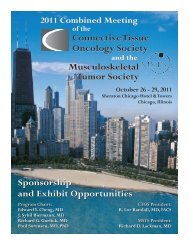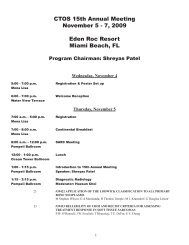207 Poster Session 2 - Connective Tissue Oncology Society
207 Poster Session 2 - Connective Tissue Oncology Society
207 Poster Session 2 - Connective Tissue Oncology Society
You also want an ePaper? Increase the reach of your titles
YUMPU automatically turns print PDFs into web optimized ePapers that Google loves.
Scientific <strong>Poster</strong>s – <strong>Poster</strong> <strong>Session</strong> 2mice. In previous studies, conventional chemotherapiesincreased the proportion of SP cells present in tumorxenografts and did not affect their ability to be seriallytransplanted. Therefore, we hypothesized that identifyingand then targeting dysregulated signaling pathwaysspecifically in SP cells will target TICs and identify noveltherapeutic approaches for UPS.Methods: Global gene expression profiling of the TIC-enrichedSP fraction and non-SP fraction was compared in15 UPS tumor samples. Gene-set enrichment analysis wasperformed using differential gene expression values andresults were visualized as a network map using Cytoscape/Enrichment Map. One hundred thousand primary UPS orxenograft tumor cells were subcutaneously injected into4-6 week old NOD/SCID/gamma mice. Pharmacologicactivation of Wnt signaling was undertaken by treatingthe mice with lithium after tumor engraftment by addingLiCl (or NaCl as a control) into drinking water at 0.6mg/lconcentration. Tumor volume, regulation of Wnt targetgenes, proliferation, apoptosis, and proportion of SP cellswere assessed after 2 weeks. The tumors were then studiedfor their ability to be serially transplanted into additionalmice, thus assessing their self-renewal capacity.Results: Gene pathway analysis identified Wnt signalingas one of the most significantly down regulated signalingpathways in SP cells of UPS tumors. In the UPS xenograftmodel, LiCl treatment increased β-Catenin (a critical mediatorof Wnt signaling) level by 30% compared with thecontrol (NaCl), upregulated expression of the Wnt targetgene Axin-2 by 2.4 times, and reduced the SP by 2.5 times.UPS xenograft tumors treated with LiCl were reduced inweight by 90% compared to the controls.Conclusion: Gene expression analysis in UPS TICs revealeddownregulation of Wnt signaling in SP cells. Thisdata suggests that pharmacologic activation of Wnt signalinghas the potential to be used as a novel therapeuticapproach to UPS treatment.<strong>Poster</strong> #155ONCOGENE DEPENDENT CONTROL OF MIRNABIOGENESIS AND TUMOR PROGRESSION INA MOUSE MODEL OF UNDIFFERENTIATEDPLEOMORPHIC SARCOMAJeffrey K. Mito 1 ; Hooney D. Min 2 ; Yan Ma 2 ; Jessica E. Carter 2 ;Brian E. Brigman 4 ; Leslie Dodd 3 ; David Dankort 5 ;Martin McMahon 6 ; David G. Kirsch 21Pharmacology and Cancer Biology, Duke University MedicalCenter, Durham, NC, USA; 2 Radiation <strong>Oncology</strong>,Duke University Medical Center, Durham, NC, USA;3Pathology, Duke University Medical Center, Durham, NC,USA; 4 Orthopaedic Surgery, Duke University Medical Center,Durham, NC, USA; 5 Biology, McGill University, Montreal,QC, Canada; 6 Cell and Molecular Pharmacology, Universityof California, San Francisco, CA, USAObjective: Undifferentiated pleomorphic sarcoma (UPS)is one of the most common soft tissue malignancies ofadulthood. Patients with large, high grade sarcomas oftendevelop fatal lung metastases. Understanding the mechanismsunderlying sarcoma metastasis is needed to improvetreatment of these patients. Micro-RNAs (miRNAs) are aclass of small RNAs that post-transcriptionally regulategene expression. Global alterations in miRNAs are frequentlyobserved in cancer. Recent data has suggested thatMAPK signaling can enhance miRNA maturation throughindirect stabilization of DICER, one of the enzymes responsiblefor miRNA processing. Moreover, mutations inDIC-ER have been identified in several subtypes of soft tissuesarcomas including UPS and rhabdomyosarcoma. To testthe relevance of specific oncogenic mutations on miRNAbiogenesis in sarcoma, we used a primary mouse modelof UPS driven by conditional mutations in Braf or Kras. Westudied how these mutations alter sarcoma initiation andprogression in the setting of Dicer haploinsufficiency.Methods: Soft tissue sarcomas were generated in mice withconditional mutations in p53 and: 1) Braf, 2) Braf andDicer,3) Kras, or 4) Kras and Dicer. Tumors were initiated by injectionof an Adenovirus expressing Cre-recombinase. Micewere followed for tumor initiation, proliferation, and thedevelopment of distant metastases. To compare rates ofmetastasis, sarcomas were removed by transfemoral amputationand animals were monitored for 6-12 months.Results: We find that Braf mutant tumors, which haveincreased MAPK signaling, have higher levels of maturemiRNAs and enhanced miRNA processing. In contrast toother tumor types, Dicer haploinsufficiency did not lead tochanges in sarcoma initiation in either Braf or Kras mutanttumors. Conversely, deletion of one allele of Dicer didlead to significant loss of miRNA expression and enhancedtumor proliferation in Kras, but not Braf, mutantsarcomas. When followed for the development of distantmetastases, Kras-Dicer mutant tumors had higher rates ofmetastatic progression.Conclusion: These results demonstrate that specific oncogenicmutations can cooperate with mutations in Dicer topromote sarcoma progression, but not initiation, in vivo.Studies examining the role of miRNA biogenesis andpatient outcomes in a large clinically annotated set of sarcomaswill help to clarify the role of miRNA biogenesis inhuman sarcoma metastasis.246






